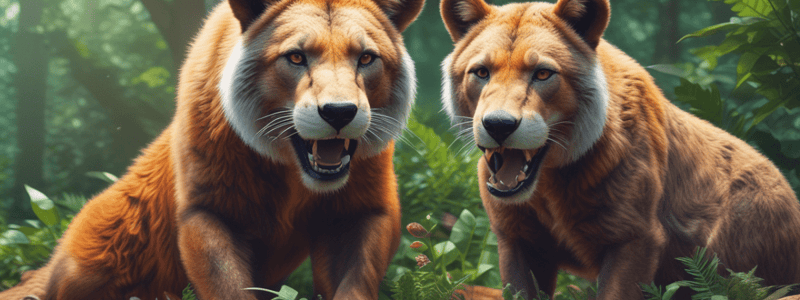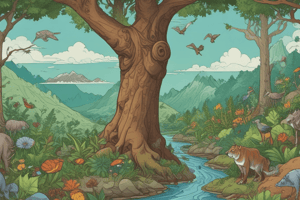Podcast
Questions and Answers
If an animal eats only mosquitoes, what type of consumer is it?
If an animal eats only mosquitoes, what type of consumer is it?
- Producer
- Herbivore
- Carnivore (correct)
- Omnivore
According to the passage, how many pounds of grass must be in the food chain for one 8-pound eagle to get enough energy?
According to the passage, how many pounds of grass must be in the food chain for one 8-pound eagle to get enough energy?
- 1 pound
- 800 pounds
- 100 pounds (correct)
- 8 pounds
Which of the following is an example of an herbivore mentioned in the passage?
Which of the following is an example of an herbivore mentioned in the passage?
- Maple tree
- Lion
- Rabbit (correct)
- Hawk
What did scientists learn about tubeworms that surprised them?
What did scientists learn about tubeworms that surprised them?
What is the role of producers in the food chain?
What is the role of producers in the food chain?
What is a carnivore?
What is a carnivore?
Which of the following is an example of an omnivore?
Which of the following is an example of an omnivore?
What is a herbivore?
What is a herbivore?
Why are most humans considered omnivores?
Why are most humans considered omnivores?
What role do producers play in the food chain?
What role do producers play in the food chain?
Which of the following organisms are considered producers in a food chain?
Which of the following organisms are considered producers in a food chain?
What is the primary source of energy for all food chains?
What is the primary source of energy for all food chains?
Which of the following animals are considered herbivores?
Which of the following animals are considered herbivores?
What is the potential impact of a vegetarian diet on food chains?
What is the potential impact of a vegetarian diet on food chains?
Which term describes an animal that consumes both plants and other animals?
Which term describes an animal that consumes both plants and other animals?
Hawks, owls, and vultures are herbivores in the desert ecosystem.
Hawks, owls, and vultures are herbivores in the desert ecosystem.
Desert animals are more likely to be omnivores due to the scarcity of food in the desert.
Desert animals are more likely to be omnivores due to the scarcity of food in the desert.
All terrestrial food chains start with plants at the base.
All terrestrial food chains start with plants at the base.
Snakes and hawks are similar in that they are both primary consumers.
Snakes and hawks are similar in that they are both primary consumers.
Desert animals that are omnivores are less likely to go hungry compared to those that are purely carnivores.
Desert animals that are omnivores are less likely to go hungry compared to those that are purely carnivores.
Humpback whales eat really big fish.
Humpback whales eat really big fish.
Soil conservationists advise on how to make land infertile and lacking in nutrients.
Soil conservationists advise on how to make land infertile and lacking in nutrients.
Ecotourist guides teach people about harming wildlife and the environment.
Ecotourist guides teach people about harming wildlife and the environment.
Terrestrial habitats can be explored further at www.eduplace.com/scpl.
Terrestrial habitats can be explored further at www.eduplace.com/scpl.
Inuit people live in the hot rainforests of South America.
Inuit people live in the hot rainforests of South America.
The desert regions usually get a lot of rainfall, making them very wet environments.
The desert regions usually get a lot of rainfall, making them very wet environments.
Cactuses store large amounts of water in their cells in order to survive in the desert.
Cactuses store large amounts of water in their cells in order to survive in the desert.
Desert herbivores include snakes that primarily feed on insects and small animals like rabbits.
Desert herbivores include snakes that primarily feed on insects and small animals like rabbits.
A food chain in the desert always starts with a producer that uses the Sun as its energy source.
A food chain in the desert always starts with a producer that uses the Sun as its energy source.
Snakes in the desert are commonly herbivores that feed on plants like cactuses.
Snakes in the desert are commonly herbivores that feed on plants like cactuses.
Flashcards are hidden until you start studying
Study Notes
Food Chains and Energy Flow
- In a food chain, one animal eats another animal or eats a plant, becoming part of the flow of energy.
- Energy from the Sun is passed from one organism to another through the food chain.
- Plants are producers, producing their own food using sunlight energy.
- Consumers, including carnivores, herbivores, and omnivores, obtain energy by eating other organisms.
Types of Consumers
- Carnivores: eat only animals (e.g., hawks, lions, spiders)
- Herbivores: eat only plants (e.g., zebra, horse, deer)
- Omnivores: eat both plants and animals (e.g., humans, ostriches, fire ants)
Food Chains in Different Habitats
- Aquatic habitats: plants and animals that live in or on water
- Terrestrial habitats: plants and animals that live on land
- Both aquatic and terrestrial habitats have producers, consumers, and decomposers
Producers
- Grasses, bushes, and trees are producers in savannas
- Producers create their own food using sunlight energy
- Producers are the first link in a food chain
Consumers in Different Habitats
- Desert habitats: adapted organisms that live in dry conditions
- Desert producers include grasses, wildflowers, and cactuses
- Desert herbivores include insects and small animals like rabbits
- Desert carnivores include snakes and coyotes
Energy Flow and Food Chains
- Energy flows from the Sun to producers, then to consumers
- Each food chain starts with a producer that uses sunlight energy
- Consumers obtain energy by eating other organisms in the food chain
Studying That Suits You
Use AI to generate personalized quizzes and flashcards to suit your learning preferences.




